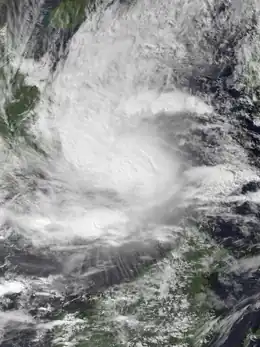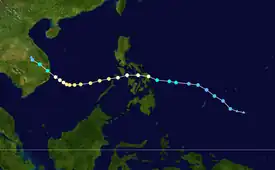Typhoon Faith
Typhoon Faith, known in the Philippines as Typhoon Norming, struck both the Philippines and Vietnam during December 1998. A tropical disturbance developed within the vicinity of the western Caroline Islands during early December. At midday on December 8, the system developed into a tropical depression. Tracking northwest at a brisk pace, the depression gradually intensified, and was upgraded into a tropical storm at noon on December 9. Quickly intensifying, Faith turned to the west-northwest, and after tracking near Samar Island on the evening of December 10, Faith attained typhoon intensity. After clipping the northern tip of Palawan Island, the typhoon entered the South China Sea at peak intensity. Across the Philippines, 33 people were killed, with 30 others wounded and 36 others listed missing. A total of 6,423 homes were damaged and 3,234 houses were destroyed, leaving more than 20,000 homeless. Damage was estimated at $25.9 million, with $6.82 million from crops, $15.9 million from public infrastructure, and $3.37 million from private infrastructure.
| Typhoon (JMA scale) | |
|---|---|
| Category 2 typhoon (SSHWS) | |
 Typhoon Faith at peak intensity | |
| Formed | December 8, 1998 |
| Dissipated | December 14, 1998 |
| Highest winds | 10-minute sustained: 120 km/h (75 mph) 1-minute sustained: 165 km/h (105 mph) |
| Lowest pressure | 970 hPa (mbar); 28.64 inHg |
| Fatalities | 63 confirmed, 36 missing |
| Damage | $45.9 million (1998 USD) |
| Areas affected | Philippines, Vietnam |
| Part of the 1998 Pacific typhoon season | |
The typhoon tracked westward before tracking west-southwest, only to decelerate to the west-northwest. Increased wind shear took toll on the storm and caused a weakening trend. On December 12, Faith lost typhoon intensity, and two days later, Faith weakened into a tropical depression. After striking Vietnam, the depression rapidly dissipated over land. At least 38 people were killed in Vietnam with over 10,000 evacuated due to flooding in low-lying areas. Damage in Vietnam exceeded $20 million.
Meteorological history

Tropical storm (39–73 mph, 63–118 km/h)
Category 1 (74–95 mph, 119–153 km/h)
Category 2 (96–110 mph, 154–177 km/h)
Category 3 (111–129 mph, 178–208 km/h)
Category 4 (130–156 mph, 209–251 km/h)
Category 5 (≥157 mph, ≥252 km/h)
Unknown
On December 8, 1998, the Joint Typhoon Warning Center (JTWC) issued a Tropical Cyclone Formation Alert for a tropical disturbance located within the vicinity of the western Caroline Islands.[1] At 06:00 UTC, the JTWC upgraded the system, which was located 565 km (350 mi) east-southeast of Palau, into a tropical depression,[2] with the JMA following suit six hours later.[3][nb 1] Initially, the depression moved fairly quickly on a northwesterly course in response to a weak trough to its north,[1] while also slowly strengthening and passing about 185 km (115 mi) north of Palau.[2] At 00:00 UTC on December 9, the Philippine Atmospheric, Geophysical and Astronomical Services Administration (PAGASA) began to track the storm and assigned it with the local name Norming.[5] At noon, PAGASA[6] and the JMA upgraded the depression to a tropical storm,[3] and six hours later, the JTWC followed suit.[7] After crossing the 10th parallel north, Faith turned towards the west-northwest, and by December 10, the storm entered a period of rapid intensification.[2] The JMA upgraded Faith into a severe tropical storm early on December 10,[3] and twelve hours later, the JTWC classified Faith, just offshore Samar Island, as a typhoon.[2]
The typhoon then tracked across the islands of Samar and Masbate, and next clipped the northern tip of Palawan Island[2] before entering the South China Sea.[8] At 18:00 UTC, the JMA upgraded Faith into a typhoon, while also estimating that it attained its peak intensity of 120 km/h (75 mph) and a minimum barometric pressure of 970 mbar (28.6 inHg).[9] After clearing the Philippines, Typhoon Faith tracked westward[2] and briefly moved west-southwest. On the evening of December 11, the JTWC increased the intensity to 170 km/h (105 mph), its peak wind speed. While maintaining peak intensity,[1] Typhoon Faith slowly decelerated while tracking on a west-northwesterly course as it approached the Vietnamese coast due to the effects of another mid-latitude trough, which eroded the subtropical ridge to its north. As a result of this pattern change, Faith began to encounter increased wind shear, which triggered a weakening trend,[2] and at 00:00 UTC on December 12, the JMA downgraded Faith into a severe tropical storm.[9][nb 2] At 00:00 UTC on December 14, Faith made landfall in Vietnam just north of Nha Trang.[2] At the time of landfall, the JTWC estimated winds of 115 km/h (70 mph)[7] while the JMA determined that Faith had weakened to a tropical depression.[3] Once inland, the storm began to quickly dissipate;[2] the JMA ceased tracking the system at noon the same day.[3]
Preparations and impact
Philippines
In advance of the typhoon, authorities issued a No. 3 storm signal,[11] even though only a No. 1 storm signal was issued for Manila.[11] On December 13, all classes in Manila were suspended.[12] Sixteen Philippine Airlines flights to and from the central Philippines were cancelled.[13] In the capital city of Manila, heavy rains caused street flooding.[14] Several villages on Samar island were flooded.[13] Around 400 people combined in the Catanduanes and Aklan provinces were evacuated to shelter due to rising floodwaters. A grocery store in Ibajay collapsed due to high winds. Toppled posts and downed trees clogged highways in the province of Sorsogon.[15] Two bodies were recovered off Dumaguete.[16] Offshore, the Philippine Navy rescued 100 people from a ferry traveling from the Philippines to Malaysia.[1] A 12 m (40 ft) boat sunk offshore Zamboanga City; all 10 of its crew were rescued to safety.[13] Off of Pilas Island, four people were rescued and eleven were missing when the boat Myra-1 sank in heavy seas.[14] Seventeen passengers were rescued, fourteen people were rendered missing, and two bodies were recovered when high waves toppled the motor vessel Lion No. 3.[17]
Overall, 33 people were killed, with 30 others wounded and 36 others listed missing.[18] A total of 6,423 homes were damaged and 3,234 houses were destroyed,[19] leaving more than 20,000 homeless.[1] Damage was estimated at $25.9 million,[nb 3] with $6.82 million from crops, $15.9 million from public infrastructure, and $3.37 million from private infrastructure.[19] The storm affected 17 provinces, and 135 evacuation centers were opened.[20] Following the storm, Philippines President Joseph Estrada pledged emergency funding for four provinces struck by the typhoon, along with a series of wintertime rainstorms.[21]
Vietnam
Faith was the second tropical cyclone to affect Vietnam that month, following Tropical Storm Dawn. Twenty-one people were killed in Khanh Hoa Province and Binh Dinh Province, including five in Da Nang.[15] Nationwide, at least 38 people were killed in Vietnam with over 10,000 evacuated due to flooding in low-lying areas. Damage in Vietnam exceeded $20 million.[1] A total of 602 homes were destroyed, another 16,327 were damaged, and 58,487 ha (144,520 acres) of rice fields were inundated.[22]
See also
Notes
- The Japan Meteorological Agency is the official Regional Specialized Meteorological Center for the western Pacific Ocean.[4]
- Wind estimates from the JMA and most other basins throughout the world are sustained over 10 minutes, while estimates from the United States-based Joint Typhoon Warning Center are sustained over 1 minute. 10-minute winds are about 1.14 times the amount of 1-minute winds.[10]
- All currencies are converted to United States Dollars using Philippines Measuring worth with an exchange rate of the year 1998.
References
- Joint Typhoon Warning Center; Naval Pacific Meteorology and Oceanography Center (1999). Annual Tropical Cyclone Report: 1998 (PDF) (Report). United States Navy, United States Air Force. Retrieved July 29, 2017.
- Gary Padgett. "Monthly Global Tropical Cyclone Summary October 1998". Retrieved July 29, 2017.
- Japan Meteorological Agency (October 10, 1992). RSMC Best Track Data – 1990–1999 (.TXT) (Report). Retrieved July 2, 2017.
- "Annual Report on Activities of the RSMC Tokyo – Typhoon Center 2000" (PDF). Japan Meteorological Agency. February 2001. p. 3. Retrieved July 29, 2017.
- Old PAGASA Names: List of names for tropical cyclones occurring within the Philippine Area of Responsibility 1991–2000. Philippine Atmospheric, Geophysical and Astronomical Services Administration (Report). Typhoon 2000. Retrieved July 29, 2017.
- "1998 PAGASA Tropical Cyclone Track Data - Typhoon Norming". June 14, 1999. Retrieved July 29, 2017.
- Typhoon 24W Best Track (TXT) (Report). Joint Typhoon Warning Center. December 17, 2002. Retrieved July 29, 2017.
- Hong Kong Observatory (1999). "Part III – Tropical Cyclone Summaries". Meteorological Results: 1998 (PDF). Meteorological Results (Report). Hong Kong Observatory. p. 27. Retrieved July 29, 2017.
- Kenneth R. Knapp; Michael C. Kruk; David H. Levinson; Howard J. Diamond; Charles J. Neumann (2010). 1998 FAITH (1998342N06141). The International Best Track Archive for Climate Stewardship (IBTrACS): Unifying tropical cyclone best track data (Report). Bulletin of the American Meteorological Society. Retrieved July 29, 2017.
- Christopher W Landsea; Hurricane Research Division (April 26, 2004). "Subject: D4) What does "maximum sustained wind" mean? How does it relate to gusts in tropical cyclones?". Frequently Asked Questions. National Oceanic and Atmospheric Administration's Atlantic Oceanographic and Meteorological Laboratory. Retrieved July 29, 2017.
- "Typhoon Faith hits central Philippines". Agence France Presse. December 11, 1998. – via Lexis Nexis (subscription required)
- "Relief operations rushed to storm ravaged Philippine provinces". Agence France-Presse. December 13, 1998. – via Lexis Nexis (subscription required)
- "Typhoon Faith hits central Philippines (2)". Agence France Presse. December 11, 1998. – via Lexis Nexis (subscription required)
- "At least eight dead, 29 missing in Philippine typhoon Faith: reports". Agence France Presse. December 12, 1998. – via Lexis Nexis (subscription required)
- "At least 21 die as typhoon hits Vietnam". Agence France Presse. December 16, 1998. – via Lexis Nexis (subscription required)
- "Relief rushed to Philippines storm-hit areas, more deaths reported". Agence France Presse. December 13, 1998. – via Lexis Nexis (subscription required)
- "Two killed, 14 missing as boat sinks in Philippine typhoon". Agence France Presse. December 11, 1998. – via Lexis Nexis (subscription required)
- Destructive Typhoons 1970-2003 (Report). National Disaster Coordinating Council. November 9, 2004. Archived from the original on November 9, 2004. Retrieved July 29, 2017.
- Destructive Typhoons 1970-2003 (Report). National Disaster Coordinating Council. November 9, 2004. Archived from the original on September 1, 2012. Retrieved July 29, 2017.
- Philippines - Typhoon Faith OCHA Situation Report No. 1. United Nations Department of Humanitarian Affairs (Report). ReliefWeb. December 17, 1998. Retrieved July 29, 2017.
- Australian Broadcasting Corporation (February 13, 1999). Emergency relief for Philippines flood victims. United Nations Department of Humanitarian Affairs (Report). ReliefWeb. Retrieved July 29, 2017.
- Office for the Coordination of Humanitarian Affairs (December 18, 1998). Vietnam —Storms and Floods OCHA Situation Report No.3. Disaster Information Center (Report). ReliefWeb. Archived from the original on March 17, 2005. Retrieved March 26, 2009.
